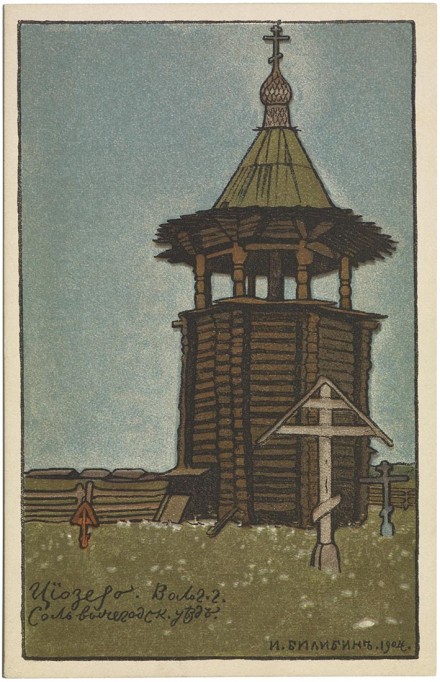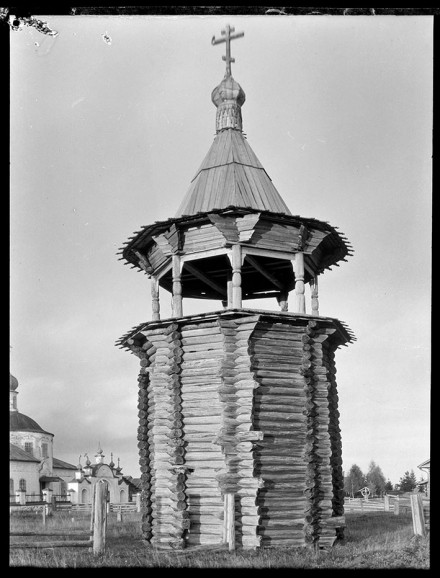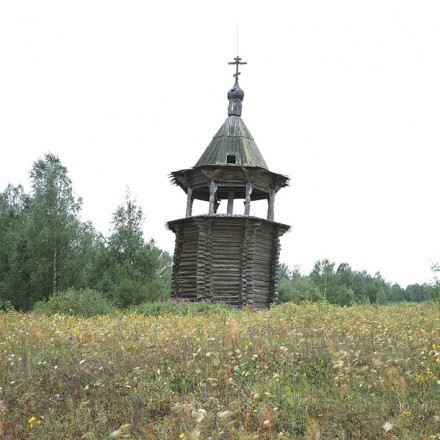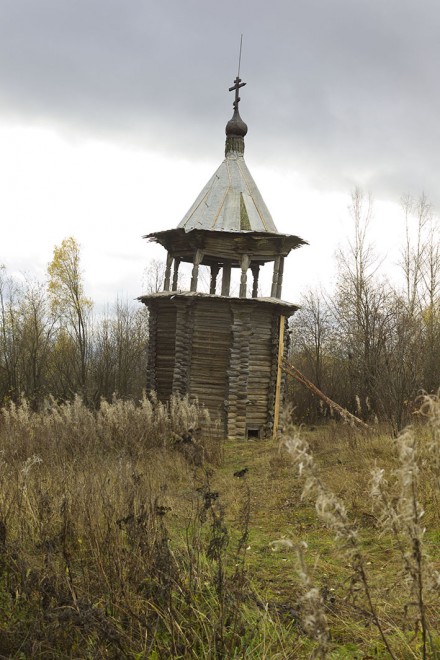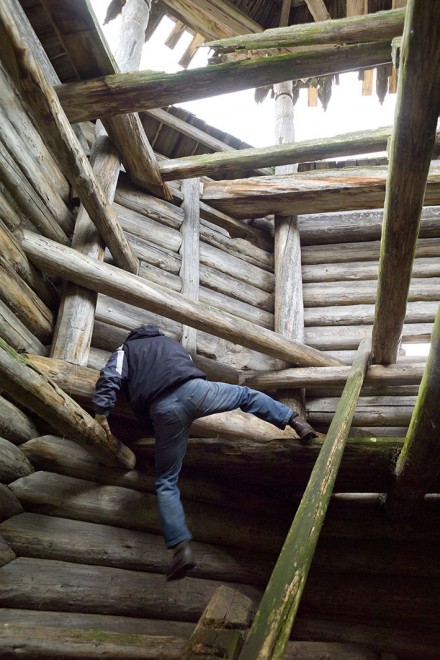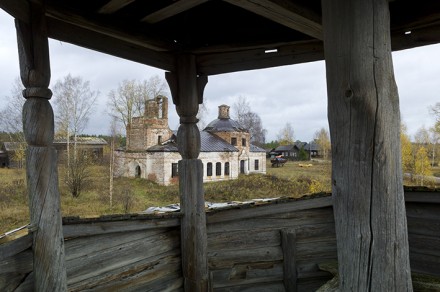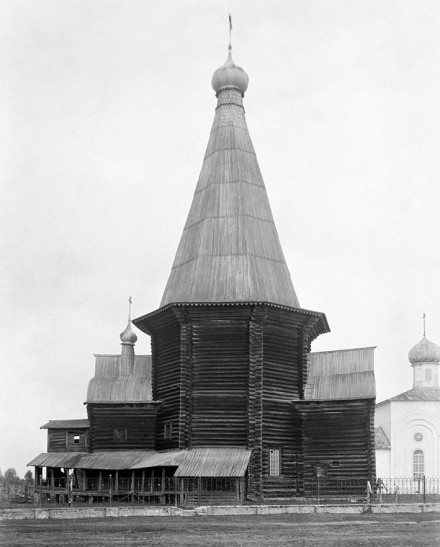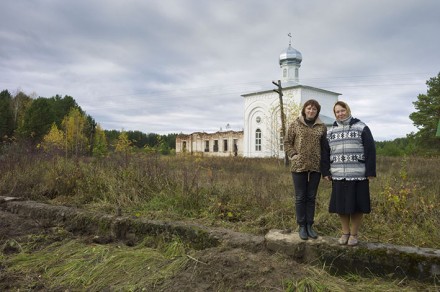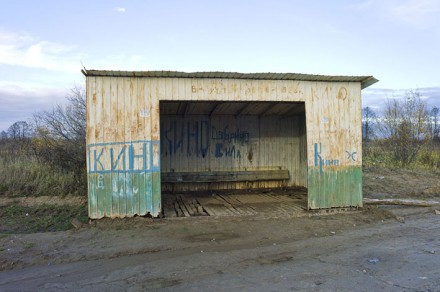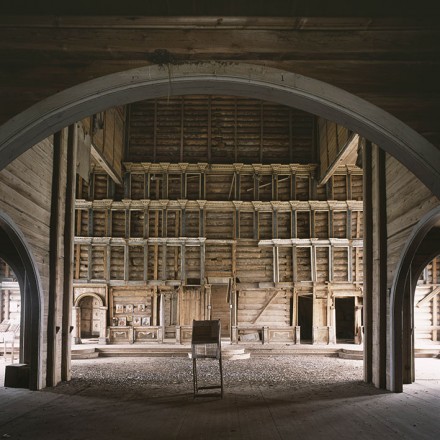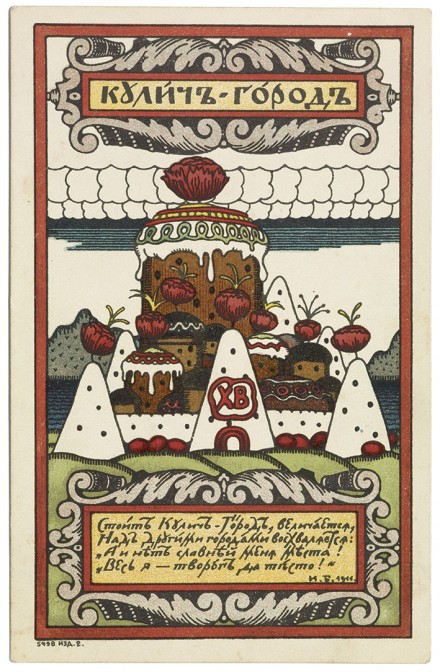Lyubov Borisovna tells the story of the burning of the Church of the Intercession and the bell tower
September 3rd, 2013 by Richard Davies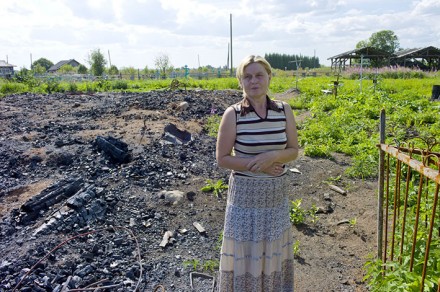
It was Easter day, 5th May 2013, and that evening I did my usual rounds to make sure that everything was shut up properly before going home. During the summer I always come out to do a final check at about 8 pm, because there are children playing out until late, there are visitors around and the grass is tinder dry. So that evening, at about 7.40pm, I cycled back to the churches. There were some children playing volleyball nearby, I stood on the porch of the Church of the Epiphany, everything seemed fine, so I decided I could go home. On the way back I noticed storm clouds gathering in the direction of Kenozero. As I reached the cafe I run, I noticed some people at the bus stop. I told Elena that it was spotting with rain and that I would go home before the heavens opened. On my way back there was a flash of lightning. I got home at 8.45 pm to find Maxim and his wife had come round. I told my husband to turn off the television because there was an electric storm brewing. As soon as I sat down at the table with my tea, there was a tremendous noise outside and three minutes later the telephone rang. It was 8.50 and Elena was screaming down the phone, ŌĆ£Lyuba, come quickly, the church is on fire!ŌĆØ As I was rushing out of the house, my husband said, ŌĆ£What’s happened?ŌĆØ and I cried, ŌĆ£The church, the church!ŌĆØ Suddenly I pulled myself together and remembered that, as church warden, it was my responsibility to contact the fire brigade. So I told the others to go on without me.
Having rung the brigade, I ran out and as I drew near the Intercession church I could see children milling around and I could see the cross at the top burning with a tiny flame. Bits of the burning cross were falling to the ground and people were stamping them out. Then a piece fell off and instead of landing on the ground, it got stuck on the tent roof. I started yelling at everyone to open the church and save the icons. My husband comforted me saying that it was starting to rain and the rain would put out the fire. No sooner were the words were out of his mouth than it stopped raining and as I looked up I saw, with horror, that one of the cupolas was alight. A fireman later explained that although it had not been obvious to us at first, the fire had probably spread down the cross into the inside of the wooden roof area, at quite an early stage. Then I decided that we all had to go into the church and save the icons. When we got inside, it was dark of course, there wasn’t any interior lighting and we didn’t have any fire fighting tools with us, not even axes. So I issued the order to break into the iconostasis in whatever way we could in order to pull out the icons. My brother had been up near the roof trying to quench the fire with two small domestic fire extinguishers. But it was hopeless. He came down and helped to put up a ladder inside the church to reach the sky ceiling and I stood below, shouting out instructions where to begin, because I knew that the sky ceiling had been cleverly designed, so that if you take out one particular piece in a corner, then all the other images can be slipped out of place quite easily. But you have to twist that one piece in a certain way to get it out. There were three men trying to put out the fire in the roof, but when they realised it was hopeless, they climbed down, shutting the doors behind them to try and contain the fire. By this time I was really frightened that we would lose all the icons and was shouting at everyone to do anything they could to break the iconostasis apart and get them out.
The trouble is that respect for the church is deeply ingrained in our people, no one would dream of causing harm or taking anything from a church, it’s a great sin. So no one would come forward. Luckily, there were more people arriving and I was able to explain that we can rebuild the walls but it would be impossible to replace the icons, they must be saved at all costs. There were a lot of children there and I must say, if it hadn’t been for them, things could have been much worse. It was the children who initially raised the alarm, then they helped us and the firemen to carry out the icons. We managed to save 36 of them. We saved the big image of Christ from the first floor level. It felt as though we had been ferrying icons out for over an hour, but when I saw the video of it afterwards, it turned out to be only ten minutes. First of all we put the icons on the covered porch of the Epiphany church for safety, but when the bell tower caught light, we realised with horror that we had better move them further away, just in case. You can imagine the scene: it’s dark, the ground’s uneven with bushes and ruts everywhere, the church is in flames, everyone’s panicking, afraid that their house will be the next to catch fire, everyone’s staggering around carrying heavy icons. Oddly enough, the men didn’t notice how heavy they were during the rescue, but the next morning, when they came back, they found that they couldnŌĆÖt lift them. Luckily, thereŌĆÖs a kind old lady who lives not far away, Nina Valentinovna Ivanova. As soon as I asked her, she agreed to have all the icons brought to her house for safety. She sat up all night guarding them.
This is a village where tradition is everything. Some of the villagers started processing round the exterior of the church carrying some of the most revered icons. When the flames started licking around the Epiphany church (you can see where the timbers are darkened), one of the firemen told me to take my icon and to stand at the corner of the church, between it and the one that was burning. And as I stood there with this most beautiful building burning fiercely in front of me, it was so hot that the icon in my hands heated up as though it was boiling water. I held it up in front of me and the flames kept on approaching and then recoiling and I had the feeling that I was doing battle, that there really was a chance that the Epiphany church might be spared. Afterwards, our tears were mixed with joy. You see, we had suffered a huge loss, words cannot describe it, we had lost the best thing the village had. What is Lyadiny without its churches? Yet at the same time, we had managed to save one of our churches. You see, regardless of what political system has been in power, in Lyadiny we have always respected and looked after our churches. They were built by our ancestors and handed down to our care and we have always taken this seriously. So now we feel at a loss. That beautiful building, crafted by our skilled ancestors, has been lost. Yet, whenever I look over this way, in my mind’s eye I still see it standing there, looking magnificent. It will always be with me and we will always celebrate the patronal feast day of the Intercession of Our Lady (Our Lady of the Veil).
You know, there was something that happened, it was about six years ago, when a group of tourists came here. It was when restoration work had just started on the Epiphany church, by a group of carpenters working in the traditional local style. I happened to be standing on the road watching them, when a car came up and the driver, a man, started asking me about the churches, what date they were and so on. I told him that, thanks be to God, we had managed to raise enough money to restore them. The man replied that the work would take years and that I would not live to see the end of it. So, I said that maybe, but that my two sons would and that this was the important thing. In Lyadiny we have always understood that what you build today is for tomorrow’s generation. So that’s how we Lyadintsy (people of Lyadiny) defended our church. And we won’t give up. We won’t accept second best. We will rebuild a proper church to replace the lost one. It may take ten or even a hundred years to build, but it will be a worthy successor and something that we are proud to hand on to subsequent generations. When it’s finished we will be weeping tears of happiness, not like today, tears of grief.
Lyubov Borisovna, 6th August 2013
translated by Daryl Ann Hardman
